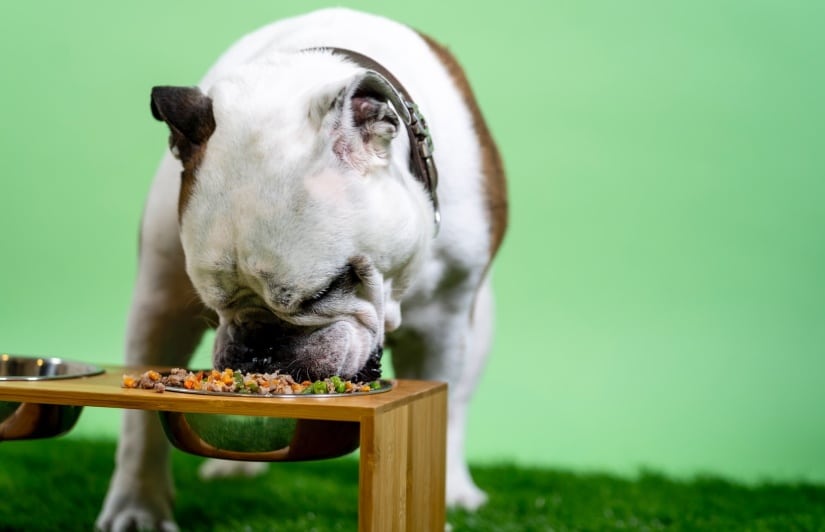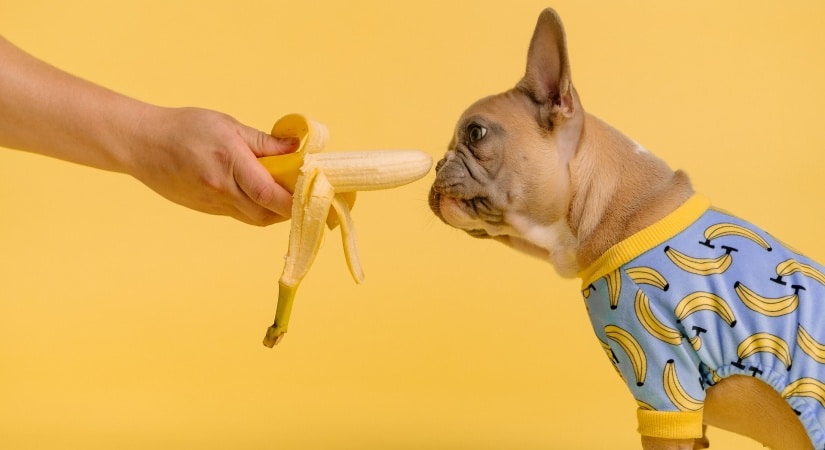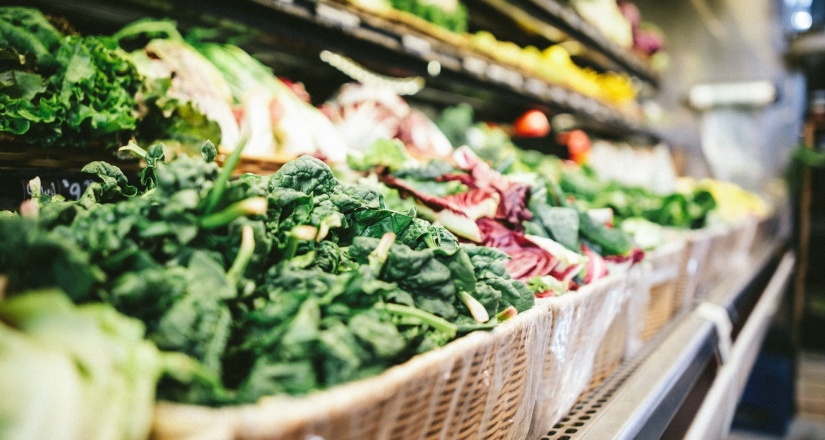If your dog is in the house when dinner time rolls around, you’re probably used to seeing those mournful eyes begging for tidbits from the dinner table. Most of us, and rightly so, avoid giving our pooches food from the table, at least during our meal.
But consider that dogs that eat commercial dog food, whether dry kibble, canned wet food, or similar, when given the chance, will eat grass once they are left to their own devices in the backyard.
This natural behavior can cause us to wonder if dogs actually can eat as we do but without sugar and sweets. In reality, dogs can eat and should eat a portion of organic foods as part of their diet.
Nowadays, commercial dog food manufacturers are increasing including some vegetables and fruits in their products, further underlining the need for organic ingredients in a balanced canine diet. Vegetables afford us a variety of vitamins, minerals, fiber, enzymes, and phytonutrients that will not be found in meat.
So, it’s important to give Pooch his daily portion of vegetables and when you prepare yours, make a bit more for man’s best friend. However, always consult your veterinarian before introducing a new vegetable into your dog’s dinner menu.
The Ancestral Canine Diet
Veterinarian Dr. Karen Shaw Becker states that “dogs like people can benefit greatly from the addition of fresh, whole foods to their diet. For dogs, fruits and vegetables should make up only a small percentage of a nutritionally balanced species-appropriate diet but including some can help to mimic their ancestral diet, similar to the one consumed by wolves, while providing valuable nutrients.”
There is no standard ancestral diet for all dogs because location, season, and availability would have heavily influenced what dogs consumed in ancient times. However, it is known that our canines’ ancestors survived on prey animals including fish and eggs.
Because they are omnivores, meaning they eat pretty much anything, they also ate grasses, nuts, fruits like berries, and plants or vegetables. Ancestral canines risked starvation, so they ate anything that was considered edible and most likely were not very picky or discerning. They probably are best described as “opportunivore” meaning they ate what happened to be available.
Providing a small portion of green vegetables can contribute to your dog’s overall health and may even reduce the amount of some of what you spend on commercial dog food.
Related: Can Dogs Eat Potatoes? The Truth about Carbohydrates
Preparing Green Vegetables for Dogs

Aside from selecting the vegetables, how you prepare them for Pooch, can make a difference. Vegetables should be sliced or chopped in pieces small enough so that your dog doesn’t choke when wolfing them down. Vegetables can also be pureed and mixed in with your dog’s regular kibble.
If your dog enjoys a particular vegetable, it can also be used as a treat as long as it does not present digestive problems. Methods for preparing vegetables for your canine buddy include:
-
● Blanching
Blanching vegetables requires submerging them rapidly in hot boiling water, and then in ice-cold water. This method will thoroughly cleanse the veggie’s surface but maintain all the nutritious elements as well as the flavor. It requires no cooking, fats, oils, or other, making it relatively quick and efficacious.
-
● Freezing
If you have a large family or like to prepare large batches of food ahead of time, freezing them to facilitate meal preparation after a long day at work is incredibly convenient. This is true also when preparing veggies for Pooch. Simply puree your chosen vegetable and place them in ice cube trays. Grab a cube or two when preparing Pooch’s dinner.
-
● Pureeing
For canines with sensitive digestion, you may want to consider pureeing. Some veggies can be pureed raw like spinach or celery. Pureeing vegetables breaks down the veggie so that they are more digestible. This is also an alternative for dogs with dental problems or without teeth.
-
● Steaming
Steaming your vegetables is another healthy alternative when preparing your dishes. You don’t need to submerge vegetables in boiling water. Steaming will cook them through while preserving nutrients, color, and flavor.
Related: Can Dogs Eat Cherries? 7 Health Dangers for Your Dog
Green Veggies for Your Beloved Canine

Here are our favorite green veggies that both your family and your beloved Pooch will appreciate when it’s time to chow down.
-
1. Broccoli
Dog food experts Timberwolf Organics explain that, “Broccoli is a superfood when it comes to vitamins containing vitamins C and K, as well as potassium that all contribute to bone density, heart health, and canine immune systems.”
Broccoli will also provide Pooch with calcium, iron, and fiber. It’s a great choice for dogs but should be fed in moderation because the florets do contain isothiocyanates that can irritate digestion. Dogs can eat broccoli whether cooked or raw.
A popular method for dog food preparation is steaming. Broccoli can be roasted but leave out spices and seasoning. Raw broccoli is ideal when pureed to facilitate digestion. If you don’t have a blender, chop it into tiny pieces.
Should you decide on raw broccoli, look for organic where pesticides and chemicals are not used. Wash your broccoli well, in any case, to remove germs before consumption.
-
2. Brussels sprouts
Similar to broccoli, Brussels sprouts bring a lot of nutrients to the table along with antioxidants. They contribute to reducing inflammation and can improve blood circulation. These yummy green vegetables contain vitamins A, B1, B6, and K together with fiber, folate, manganese, and potassium. They also work to keep the colon clean but can be a stimulant for gas. To serve them to your dog, remove the tough stem, cook them, and slice them small enough for your pooch to enjoy.
-
3. Celery
Celery is another green vegetable that can be healthy for your dog when added in moderation to a regular diet with other important pet food ingredients. It is particularly indicated as a crunchy treat for dogs that may be overweight or obese. Apart from fiber, it brings vitamins A, B5, C, and K as well as magnesium, calcium, and potassium to the diet. Vitamin A will promote a healthy fur coat and skin, while fiber will aid the digestive tract yet not add calories.
Celery can be given to your pup raw in small pieces while senior canines may prefer it cooked because it is easier to chew.
-
4. Cucumbers
Low in calories, cucumber is another healthy treat that dogs will enjoy. Like celery, it contains a lot of water, approximately 96% making it great for hydration and ideal for weight loss. Another terrific advantage is the cucumber’s effect on bad doggie breath. These green veggies are full of phytonutrients and phytochemicals that will contrast mouth bacteria, leaving breath fresher.
Cucumber can be served either raw or cooked and will mainly depend on what your fur baby prefers. Raw cucumber will retain more nutritional value and be simpler to serve. If your pup loves cucumbers, consider giving it as a treat.
-
5. Green Beans
Vitamins A, B6, C, and K, together with calcium and iron are all good reasons to give Pooch green beans. These vegetables are low in calories yet rich in fiber, meaning they help you feel full. If you have a dog that likes to overeat, green beans may offer added benefits.
Unseasoned, plain green beans are a healthy diet supplement. Moderation is the rule to avoid digestive irritation resulting in diarrhea or gas. Your Pooch can eat green beans that are canned, raw, pureed, blanched, or steamed but avoid salt and seasonings. Organic is better to avoid chemicals and always wash the beans well before preparing.
-
6. Kale
This gorgeous leafy green is known to contribute to healthy vision, bones, the immune system, energy, and fetal development. Your canine can eat kale safely. If your dog overeats or is a bit overweight, a small portion of kale added to the daily meal may help. It’s low calorie, can aid digestion, and is packed full of vitamins. Whether served raw, chopped finely, or steamed, avoid seasoning or additives when integrating kale into your dog’s diet. Begin by introducing it slowly to your pup and select organic. Kale, like spinach, contains oxalates hence always served in small amounts with moderation.
-
7. Spinach
Spinach is the green superfood for everyone, including your dog. Magnesium, potassium, carotenoids, iron, folic acid, calcium, and vitamins B6, B9, C, E, and K are all part of the nutritious treasure cache found in this leafy green vegetable. Great for canines because it is nutrient-rich, the amount should correspond to your dog’s size, and in any case, because Pooch is a carnivore, 75 to 85% of the canine diet should be meat-based.
Blanching, pureeing, or steaming are all methods for preparing Pooch’s portion. Organic is preferable to avoid your dog ingesting pesticides or chemicals and avoid seasoning as well as onions or garlic which are toxic for dogs. Serving a small amount mixed in with a meal may be the best way to introduce spinach into the diet. If your dog tends to develop kidney or bladder stones, avoid serving spinach.
A Final Thought
Vegetables are one more thing that you can share with your favorite four-legged pal, and you’ll be contributing not only to your health and to your family’s health, but your beloved canine’s health as well.

